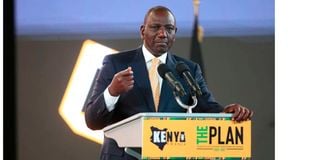Why ‘The Plan’ could usher in ‘Glorious Five’

President William Ruto when he launched the Kenya Kwanza manifesto at Kasarani on June 30, 2022.
The post-war French period from 1945 to 1975, during which the European country experienced exceptional growth, has come to be known as ‘The Glorious Thirty’—Trente Glorieuses in French. Under the leadership of President Charles de Gaulle, France’s real income expanded, and so did overall private consumption.
The economic growth rate path is seldom clear-cut and the ravages of the Great Depression initially dampened any real progress in the inter-war period (between the two World Wars). It was ravaged by disease, a housing crisis and high cost of living.
President De-Gaulle introduced a raft of measures to improve productivity. He exploited foreign aid received through the Marshall Plan to rebuild the country and resolve the housing crisis. He oversaw the proper use of fiscal and monetary policy to address market failures and redistribute income. In economic parlance, this model, as applied in South East Asia, is referred to as being dirigiste—denoting substantial state control over a capitalist economy.
After three decades, France had transformed into a modern welfare state with a high standard of living. Average wages had risen and consumer purchasing power among the highest in Europe.
Sixty years after Independence, Kenya is grappling with similar ills—unemployment, inflation and a housing deficit. The economy grew at an average 4.8 per cent in 2008 -2022, below the 10 per cent target. The share of manufacturing in gross domestic product declined from 10.4 per cent to 7.8 per cent. This may paint a bleak outlook but, for an economy that has shaken off the effects of the 2008 global financial crisis and the 2020 Covid-19 pandemic, it is a show of resilience. Per capita income rose to $1,430 in 2014, propelling the country to the lower middle-income bracket.
The Kenya Vision 2030 envisages a newly industrialised middle-income country with a high quality of life by 2030. The recent launch of the 4th Medium-Term Plan, which prioritises investment in productive sectors of the economy, looks set to usher in a ‘glorious five’ years. It comes at a time the shilling is strengthening and the fuel prices have dropped.
The Plan is anchored on five pillars—agriculture; healthcare; housing and settlement; micro, small and medium enterprises (MSMEs) economy; and the digital superhighway and creative economy. This essentially makes it a ‘Big Five’ agenda as opposed to its predecessor, the ‘Big Four Agenda’.
In 2007-2022, internet penetration in Kenya shot up from 7.7 per cent to 93.93 per cent. Investment in the digital superhighway would further solidify the country’s primacy as the technological hub of the Eastern African region.
It is usually difficult for predominantly agricultural nations to exploit their comparative advantages in raw material exports due to fluctuations of international prices and other challenges of the global financial system. As such, the government’s plan to invest in key product value chains would promote export-oriented industrialisation.
Mr Reyia is an economist. [email protected].



